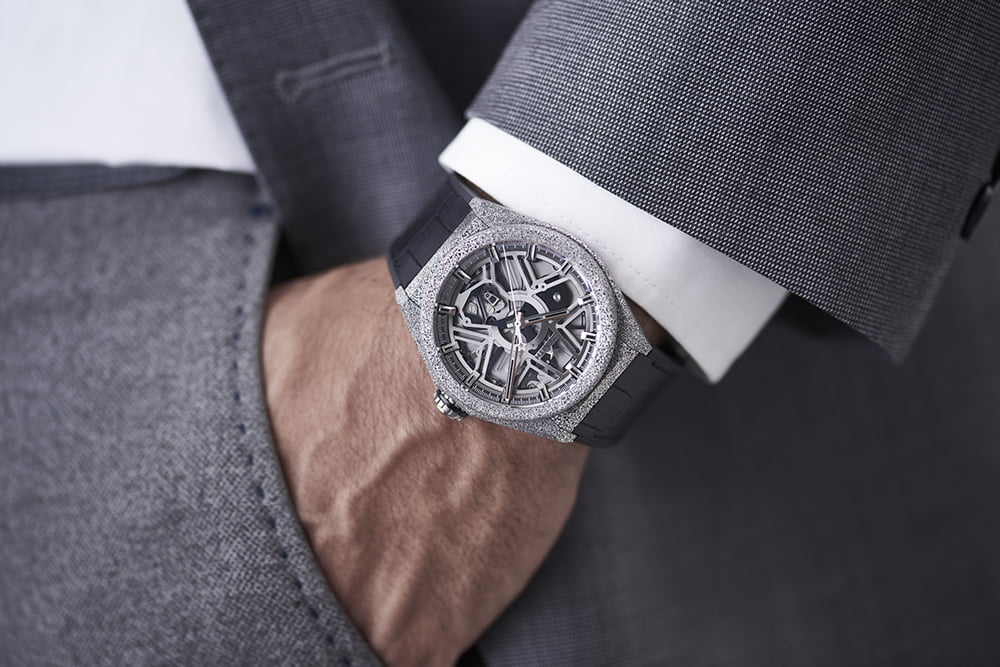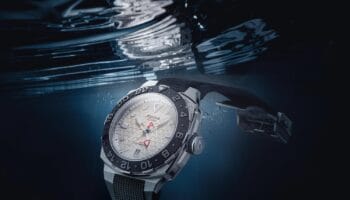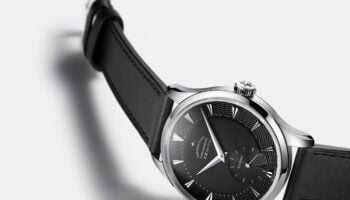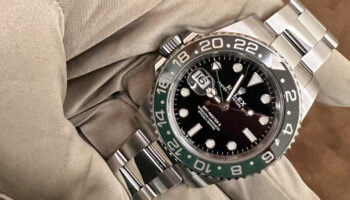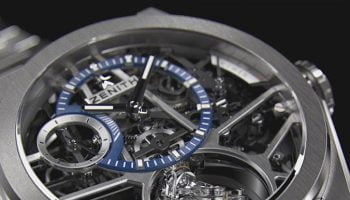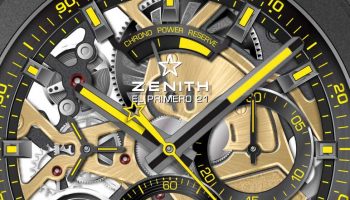A new oscillator representing a major innovation in the watch industry since the 1675 invention of the balance and hairspring principle by scientist Christiaan Huygens. The 21st century Defy Lab achieves exceptional performance making it a master of mechanical precision powered into a whole new dimension.
Zenith is writing its future and starting a new chapter in the history of the Swiss watch industry. Manufacture Zenith has been making mechanical watches for 152 years and currently has the capacity to produce around 40 different movements (featuring various shapes and equipped with complications), reflecting its exceptional expertise.
Zenith is now renewing ties with innovation and fundamental research by presenting Defy Lab and its new oscillator – an invention that challenges nothing less than the operating principle of mechanical watches invented by Christian Huygens in the 17th century. The announcement was made at a press conference held at the Manufacture Zenith in Le Locle and hosted by Jean-Claude Biver, President of the Watch Division, along with Zenith CEO Julien Tornare and Guy Sémon, CEO of the R&D Institute, LVMH Watch Division. This innovative watch was developed through achieving effective synergies between the skill sets cultivated by the brands composing the group’s Watch Division, an endeavour overseen by Guy Sémon.
Connoisseurs will scarcely need reminding of the paternity of the Swiss watch industry’s first ever automatic chronograph introduced in 1969, which also featured a function that had not yet been seen nor even imagined at the time. Nobody was capable of measuring tenths of a second, the unit of time naturally stemming from a 5 Hz oscillation frequency. It represented a kind of watchmaking Holy Grail! The El Primero movement is often cited and has indeed become a Swiss watchmaking legend that vividly reflects Zenith’s enduring attachment to innovation and the quest for precision.
A few key points:
- Defy Lab is the first and only mechanical watch embodying both an evolution and an improvement of the sprung balance principle presented in January 1675. Since 1675, the principle of the coupled balance and hairspring (sprung balance) that Christiaan Huygens presented to the French Royal Academy of Sciences in the form of a clock has remained unchallenged. While it has definitely been improved and is undoubtedly now optimised to the greatest possible extent, it has nonetheless never called into question as such, instead regarded as both timeless and invariable.
- A new oscillator forming a monolithic whole, made of monocrystalline silicon (with details finer than a human hair), replaces the sprung balance. The 30 or so components of a standard regulating organ (which requires assembly, adjustment, timing, testing and lubrication) are thus replaced by a single element measuring just 0.5 mm thick (compared with the usual 5 mm.)
- This breathtaking development beats at the incredible frequency of 15 Hertz, with an amplitude of +/- 6 degrees, and is endowed with an almost 60-hour power reserve – more than 10% more than that of the El Primero – despite a three times higher frequency.
- This frequency endows it with an exceptional – almost 10 times higher – degree of accuracy. Its mean daily rate is precise to within just 0.3 seconds. (By way of example, one of the criteria for COSC “chronometer” certification is the average daily rate on the first ten days of testing: from -4 seconds to +6 seconds, meaning up to 10 seconds per day).
- No need for oil: no more contact means no more friction or wear, and thus no need for lubrication.
- Insensitivity to temperature gradients, gravity and magnetic fields eliminates the key weaknesses of the current balance-and-spring assemblies that are subject to deformation and/or dilatation, thereby leading to diminished precision.
- Defy Lab is triple certified, including chronometer certification displayed by by the viper’s head emblem awarded by Besançon Observatory, on behalf of the International Bureau of Weights and Measures. With regard to thermal behaviour, the spectrum of the ISO-3159 standard has been broadened: variations of around 0.3 seconds per day and per degree Celsius of deviation are certified, which is twice as good as the recommended figure. Finally, the watch meets the ISO-764 magnetic criteria, exceeding them by 18 times (for the completed watch), meaning it can withstand 88,000 Amperes per meter or 1,100 Gauss.
- This mechanism opens up whole new vistas and enters a new dimension, representing no less than a reinvention of the Huygens principle with another mechanical system.
- The first ten ZENITH Defy Lab watches (10 different versions, each is different) are sold in an exceptional collector’s gift box. All are already pre-sold.
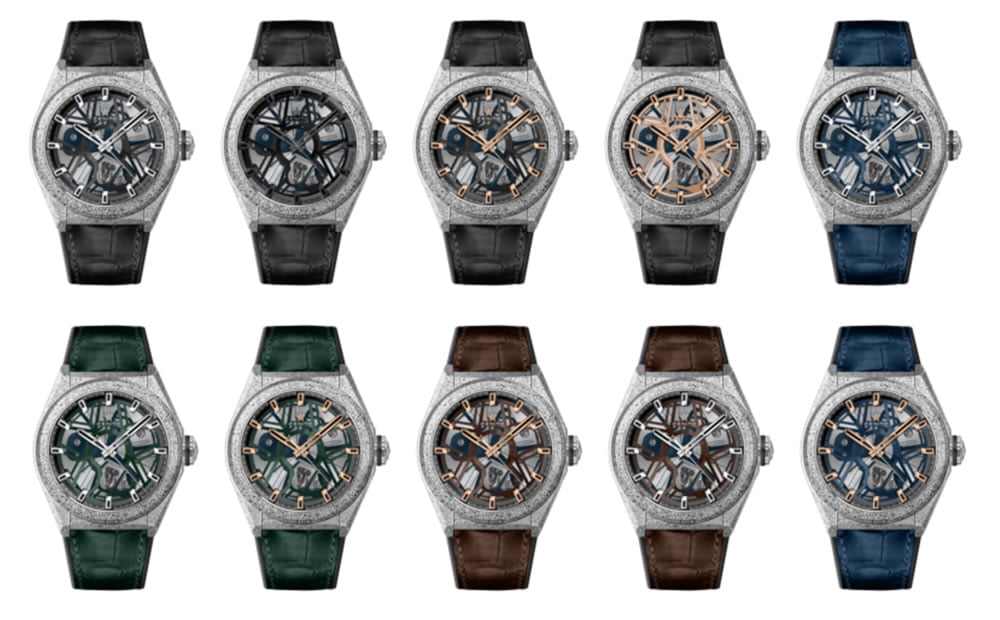
Exterior of the Defy Lab
- First watch with a case (44 mm in diameter) made from Aeronith, the world’s lightest aluminium composite material.
- This new material resembling an extremely solid metal foam was developed using an exclusive high-tech process and features a density of just 1.6 kg/dm3, which is 2.7 times lighter than titanium, 1.7 times lighter than aluminium and 10% lighter than carbon fibre.
Reinventing the mechanical watch
In 1675, the Dutch astronomer, mathematician and physicist Christiaan Huygens demonstrated the principle of regulating time by means of a coupled balance and spring fitted inside a clock, a concept that still forms the basis of all current mechanical watches. This invention was partly based on the work of the learned mechanical scientist Ignace Gaston Pardies, who corresponded with Newton. Pardies presented the theory of the isochronism of mechanical vibrations to the French Academy of Sciences in 1673, but unfortunately died before being able to publish his proofs. In 2017, a new scientific endeavour conducted by Guy Sémon challenges the principle invented by Christiaan Huygens 342 years earlier: namely the regulation of mechanical watches by means of a balance and hairspring assembly.
Performance, simplification and aesthetic impact
For the first time in the history of watchmaking, a technological breakthrough supersedes the Christian Huygens principle in terms of performance, aesthetic impact and simplicity. This is truly uncharted territory. The acknowledged champion of high-frequency chronographs, thanks to its fabled El Primero movement, the Zenith brand shifts up to ultra-high accuracy with the Defy Lab watch representing a true quantum leap in terms of performance and engineering.
Committed to tradition
1969: Zenith makes its stellar contribution to the chronograph saga by presenting the El Primero (meaning ‘the first’ in Esperanto): an integrated automatic column-wheel mechanism beating at the high frequency of 36,000 vibrations/hour (5 Hz) enabling it to reach chronometer-certified tenth of a second precision. It is to this day the world’s most accurate series-made chronograph.
March 2017: A new record, yet based on the same DNA. Zenith is introducing a 1/100th of a second series-made watch: the Defy El Primero 21. This chronograph displays hundredths of a second via a central hand, and, with a frequency de 50 Hz, is ten times faster and more accurate than its illustrious predecessor. It marks the first time that the 1/100th of a second chronograph has been released as a series-made watch. It also marks the birth of the brand new “Defy” line of Zenith watches, defined by the innovation which lies at their heart. This line is the first of many fruits to stem from Zenith’s revival.
September 2017: Precision and reliability are firmly embedded in the DNA of the 1969 El Primero movement as well as in the new Defy El Primero 21. Given that the brand holds a record-breaking 2,333 chronometry prizes, it is hardly surprising that the ZO 342 calibre powering the Defy Lab reflects Zenith’s ongoing quest for innovation and high precision. By adopting an entirely new scientific approach in modelling and innovating with regards to the mechanical watch, and by using new modern mechanical methods, the LVMH Watch Division R&D Institute has completely renewed the very concept of this type of watch. Impressive key characteristics demonstrate the scope of this stunning development: an oscillator consisting of two components made of monocrystalline silicon, an unbelievable 15 Hz frequency with an amplitude of +/- 6 degrees, as well as a 60-hour power reserve, which is 10 percent more than that of the El Primero in spite of tripled frequency. Moreover, the new Zenith Oscillator takes the form of a single piece without any mechanical linkages, instead of the customary 30 or so parts that require assembly, adjustment, setting, testing and lubrication.
High Tech & High Mech
With the Defy Lab, Zenith introduces a completely revamped movement called the ZO 342. This calibre measuring 32.8 mm in diameter and 8.13 mm thick reveals its distinctive nature at first glance: the barely 0.5 mm thick Zenith Oscillator appears beneath the dial. Its functionality has been considerably optimized: the Zenith Oscillator is an all-of-a-piece organ without mechanical linkages that replaces the 30 or so ordinarily assembled, adjusted, regulated and controlled parts. The absence of conventional mechanical couplings eliminates contact, friction, wear, slack, lubrication, assemblies and dispersions. The wheel replacing the escape wheel has a specific design and its cycle does not correspond to the traditional behaviour of a Swiss lever escapement. It is made of silicon showing superficial oxidation.
Extremely high frequency
The Zenith Oscillator beats at a frequency of 15 Hz (108,000 vibrations per hour) frequency, three times higher than that of the historical El Primero movement, while enjoying a 10 percent higher power reserve. There is no sign of jerking and the permanent running seconds hand rotates smoothly around the dial. This simple comparison makes it possible to appreciate the improvement in energy consumption compared to a conventional balance & hairspring system. The amplitude is +/- 6 degrees, as against the more than 300 degrees of a conventional system.
Committed to precision
The precision of the Defy Lab “naturally” meets the requirements of the ISO-3159 standard and in fact exceeds them. Never before in watchmaking history and in no chronometry contests has a serially produced mechanical watch ever attained such a degree of precision. Isochronism in serial production amounts to +/- 0.5 seconds from 0 to 48 hours. By way of comparison, the best conventional serial-production systems show a variation in the range of +/- 2 seconds over just 24 hours. Beyond that, precision logically diminishes in accordance with a purely physical phenomenon. The precision of a sprung balance is dependent on its amplitude, which is not the case with the Zenith Oscillator technology.
Technical specifications
Reference: 27.9000.342/78.R582 • 10 unique pieces (each is different) • Zenith oscillator (Calibre ZO 342) • Monolithic regulating organ (Zenith Oscillator) made out of Silicon • Calibre 14¼“` • Diameter: 32.80 mm • Movement thickness: 8.13 mm • Components: 148 • Jewels: 18 • Frequency: 108,000 VpH (15 Hz) • Power-reserve: approx. 60 hours • Finishing: Oscillating weight adorned with “Côtes de Genève” motif • Functions: Hours, minutes and central seconds • Case, dial & hands: Diameter: 44 mm • Opening diameter: 35.5 mm • Thickness: 14.5 mm • Crystal: Domed sapphire crystal with anti-reflective treatment on both sides • Case-back: Transparent sapphire crystal • Material: Aeronith • Water-resistance: 5 ATM • Dial: Openworked • Hour-markers: Rhodium-plated, faceted and coated with black varnish • Hands: Rhodium-plated, faceted and coated with black varnish. Strap & Buckle: Black rubber with alligator leather coating • Titanium double folding clasp


